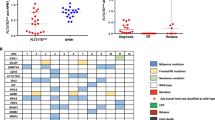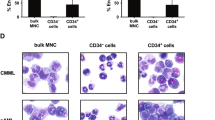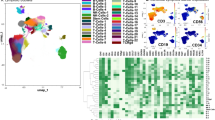Abstract
We have experienced a number of cases of AML1/ETO+ acute myelogenous leukemia that showed remission based on bone marrow (BM) morphological criteria, but that revealed clonal abnormalities in most cells by fluorescence in situ hybridization (FISH). Interestingly, most of these cases had AML with AML1/ETO rearrangement. The malignant cells were differentiated and considered mature cells after granulocyte-colony stimulating factor (G-CSF) treatment. To clarify the possible mechanisms underlying this phenomenon, we investigated the expression levels of G-CSFR in AML cells with AML1/ETO rearrangement by flow cytometry and real-time polymerase chain reaction (PCR). The number of AML1/ETO+ cells expressing G-CSFR at baseline was significantly higher than that of AML1/ETO− AML cells (2673 vs 522). In addition, the G-CSFR gene was more highly expressed in AML1/ETO+ cells than in AML1/ETO− cells by real-time PCR. This study reveals that cases showing remission after treatment with G-CSF mostly had leukemia with AML1/ETO rearrangement. This finding might be explained by the higher expression of G-CSF receptor in AML1/ETO+ cells than in AML1/ETO− cells. We recommend that remission should be confirmed by FISH, because malignant clones can be differentiated and masked in morphological examination or chromosome test, especially for AML with AML1/ETO rearrangement.
This is a preview of subscription content, access via your institution
Access options
Subscribe to this journal
Receive 12 print issues and online access
$259.00 per year
only $21.58 per issue
Buy this article
- Purchase on Springer Link
- Instant access to full article PDF
Prices may be subject to local taxes which are calculated during checkout



Similar content being viewed by others
References
Graf M, Hecht K, Reif S, Pelka-Fleischer R, Pfister K, Schmetzer H . Expression and prognostic value of hemopoietic cytokine receptors in acute myeloid leukemia (AML): implications for future therapeutical strategies. Eur J Haematol 2004; 72: 89–106.
Shimizu K, Kitabayashi I, Kamada N, Abe T, Maseki N, Suzukawa K et al. AML1-MTG8 leukemic protein induces the expression of granulocyte colony-stimulating factor (G-CSF) receptor through the up-regulation of CCAAT/enhancer binding protein epsilon. Blood 2000; 96: 288–296.
Metcalf D . The molecular control of cell division, differentiation commitment and maturation in haemopoietic cells. Nature 1989; 339: 27–30.
Demetri GD, Griffin JD . Granulocyte colony-stimulating factor and its receptor. Blood 1991; 78: 2791–2808.
Fukunaga R, Ishizaka-Ikeda E, Nagata S . Purification and characterization of the receptor for murine granulocyte colony-stimulating factor. J Biol Chem 1990; 265: 14008–14015.
Nicholson SE, Novak U, Ziegler SF, Layton JE . Distinct regions of the granulocyte colony-stimulating factor receptor are required for tyrosine phosphorylation of the signaling molecules JAK2, Stat3, and p42, p44MAPK. Blood 1995; 86: 3698–3704.
Dong F, Liu X, de Koning JP, Touw IP, Hennighausen L, Larner A et al. Stimulation of Stat5 by granulocyte colony-stimulating factor (G-CSF) is modulated by two distinct cytoplasmic regions of the G-CSF receptor. J Immunol 1998; 161: 6503–6509.
Xavier L, Cunha M, Goncalves C, Teixeira Mdos A, Coutinho J, Ribeiro AC et al. Hematological remission and long term hematological control of acute myeloblastic leukemia induced and maintained by granulocyte-colony stimulating factor (G-CSF) therapy. Leuk Lymphoma 2003; 44: 2137–2142.
Takamatsu Y, Miyamoto T, Iwasaki H, Makino S, Tamura K . Remission induction by granulocyte colony-stimulating factor in hypoplastic acute myelogenous leukemia complicated by infection. A case report and review of the literature. Acta Haematol 1998; 99: 224–230.
Ferrara F, Di Noto R, Viola A, Russo C, Boccuni P, Costantini S et al. Complete remission in acute myeloid leukaemia with t(8;21) following treatment with G-CSF: flow cytometric analysis of in vivo and in vitro effects on cell maturation. Br J Haematol 1999; 106: 520–523.
Nimubona S, Grulois I, Bernard M, Drenou B, Godard M, Fauchet R et al. Complete remission in hypoplastic acute myeloid leukemia induced by G-CSF without chemotherapy: report on three cases. Leukemia 2002; 16: 1871–1873.
Lee DY, Cho HI, Kang YH, Yun SS, Park SY, Lee YS et al. The role of fluorescence in situ hybridization (FISH) for monitoring hematologic malignancies with BCR/ABL or ETO/AML1 rearrangement: a comparative study with FISH and G-banding on 919 consecutive specimens of hematologic malignancies. Cancer Genet Cytogenet 2004; 152: 1–7.
Lee KY, Suh BG, Kim JW, Lee W, Kim SY, Kim YY et al. Varying expression levels of colony stimulating factor receptors in disease states and different leukocytes. Exp Mol Med 2000; 32: 210–215.
Camera A, Volpicelli M, Villa MR, Risitano AM, Rossi M, Rotoli B . Complete remission induced by high dose erythropoietin and granulocyte colony stimulating factor in acute erythroleukemia (AML-M6 with maturation). Haematologica 2002; 87: 1225–1227.
Piccaluga PP, Martinelli G, Malagola M, Rondoni M, Bianchini M, Visani G et al. Complete remission in acute myeloid leukemia with granulocyte-colony stimulating factor without chemotherapy. Report of cytogenetic remission of a t(9;11)(p22q23) positive AML patient and review of literature. Haematologica 2003; 88: ECR28.
Matsushima T, Saitoh T, Karasawa M, Takizawa M, Miyawaki S, Nojima Y et al. Effect of cytokines on growth and differentiation of leukaemic cells with translocation t(6;9)(p23;q34). Br J Haematol 2001; 115: 812–816.
Delwel R, Dorssers L, Touw I, Wagemaker G, Lowenberg B . Human recombinant multilineage colony stimulating factor (interleukin-3): stimulator of acute myelocytic leukemia progenitor cells in vitro. Blood 1987; 70: 333–336.
Colombat P, Santini V, Delwel R, Krefft J, Bredmond JL, Lowenberg B . Primary human acute myeloblastic leukaemia: an analysis of in vitro granulocytic maturation following stimulation with retinoic acid and G-CSF. Br J Haematol 1991; 79: 382–389.
Lee KW, Choi IS, Roh EY, Kim DY, Yun T, Lee DS et al. Adult patients with t(8;21) acute myeloid leukemia had no superior treatment outcome to those without t(8;21): a single institution's experience. Ann Hematol 2004; 83: 218–224.
Klampfer L, Zhang J, Zelenetz AO, Uchida H, Nimer SD . The AML1/ETO fusion protein activates transcription of BCL-2. Proc Natl Acad Sci USA 1996; 93: 14059–14064.
Pabst T, Mueller BU, Harakawa N, Schoch C, Haferlach T, Behre G et al. AML1-ETO downregulates the granulocytic differentiation factor C/EBPalpha in t(8;21) myeloid leukemia. Nat Med 2001; 7: 444–451.
Rhoades KL, Hetherington CJ, Harakawa N, Yergeau DA, Zhou L, Liu LQ et al. Analysis of the role of AML1-ETO in leukemogenesis, using an inducible transgenic mouse model. Blood 2000; 96: 2108–2115.
Kutlay S, Beksac M, Dalva K, Ilhan O, Koc H, Akan H et al. The detection of flow cytometric G-CSF receptor expression and it's effect on therapy in acute myeloid leukemia. Leuk Lymphoma 2003; 44: 791–795.
Acknowledgements
We thank Dr Dong Yook Kim (Department of Internal Medicine of the Catholic University of Korea, College of Medicine, Seoul, Korea) for providing samples of AML. This study was supported by the National Research Laboratory Program of the Ministry of Science and Technology (M1-0302-00-0112).
Author information
Authors and Affiliations
Corresponding author
Rights and permissions
About this article
Cite this article
Moon, H., Shin, S., Kim, H. et al. Therapeutic use of granulocyte-colony stimulating factor could conceal residual malignant cells in patients with AML1/ETO+ acute myelogenous leukemia. Leukemia 20, 1408–1413 (2006). https://doi.org/10.1038/sj.leu.2404286
Received:
Revised:
Accepted:
Published:
Issue Date:
DOI: https://doi.org/10.1038/sj.leu.2404286
Keywords
This article is cited by
-
Priming with GM-CSF instead of G-CSF enhances CAG-induced apoptosis of acute monocytic leukemia cells in vitro
Cancer Chemotherapy and Pharmacology (2019)
-
The Transcriptome Study of Subtype M2 Acute Myeloblastic Leukemia
Cell Biochemistry and Biophysics (2015)



